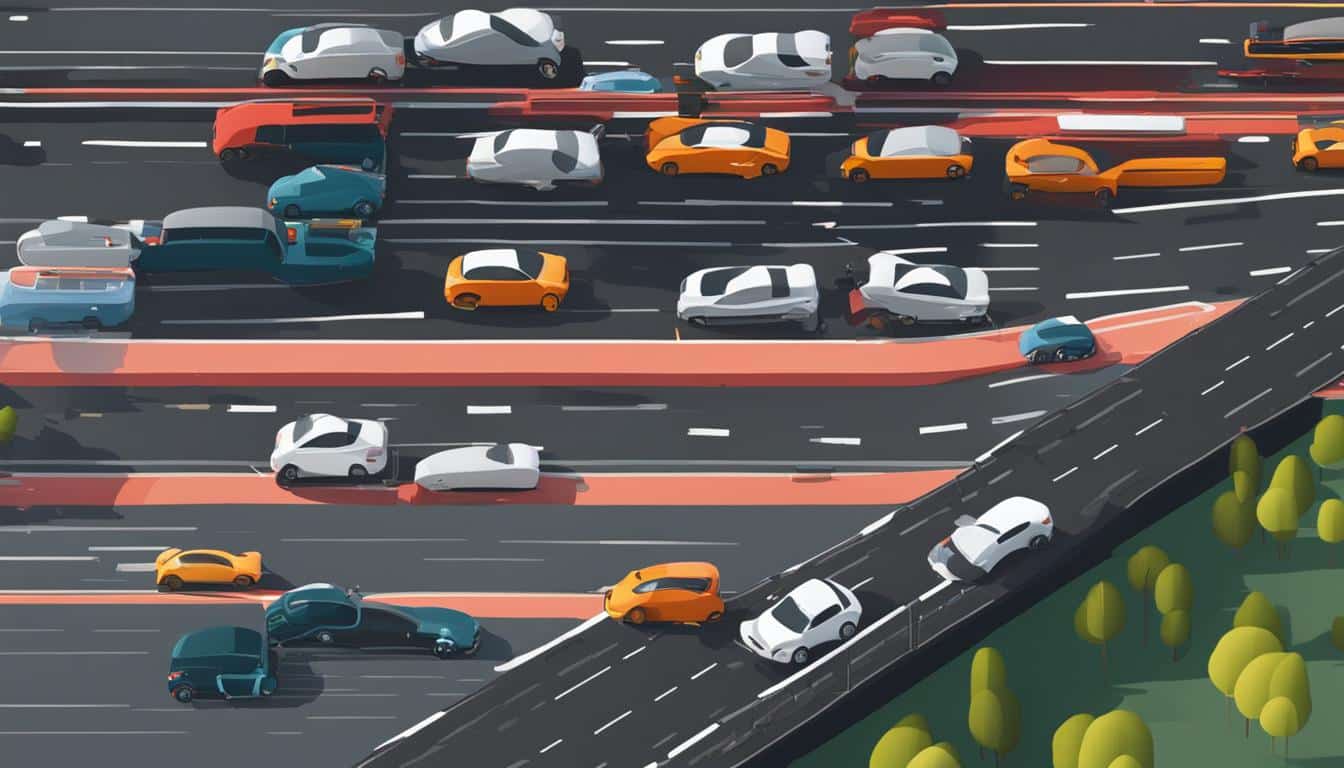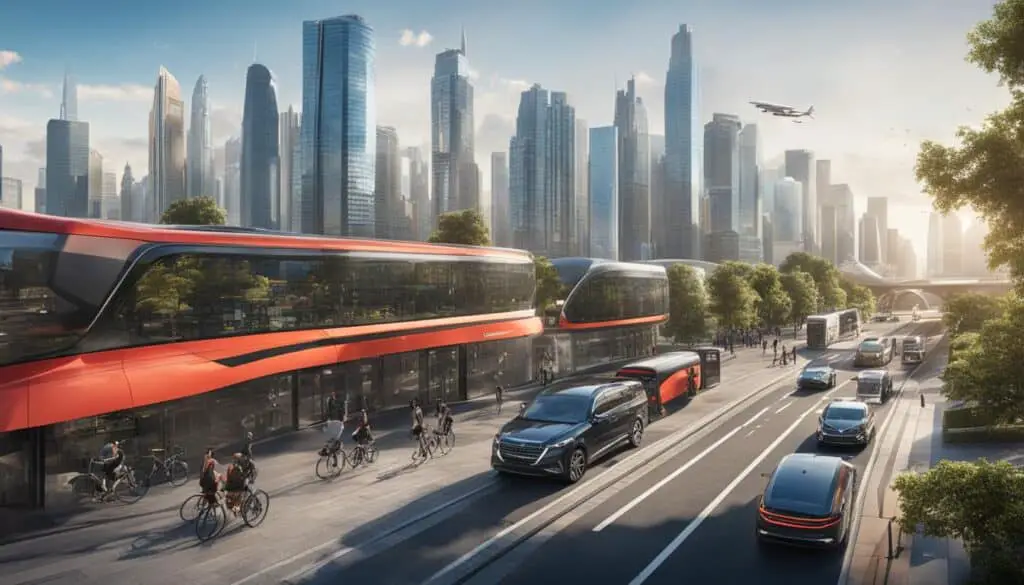
Autonomous Vehicles and Their Impact on the Job Market
The introduction of autonomous vehicle technology is expected to have a profound impact on the job market. Research shows that the sale of autonomous vehicles is projected to reach 58 million units in just eight years, with a market value of over $2 trillion. While there are benefits to driverless vehicles, such as reduced risk of accidents and increased mobility for non-drivers, there are also concerns about potential job loss and the high cost of integration.
Reports indicate that up to 5 million jobs in the US could be lost, including 3.5 million truck drivers. However, new jobs are expected to emerge in the shared mobility transport system. It is clear that autonomous vehicles will reshape industries and job opportunities in the modern world.
Key Takeaways:
- Autonomous vehicles are projected to reach 58 million units in just eight years.
- There are concerns about potential job loss and the high cost of integration.
- Up to 5 million jobs could be lost in the US, including 3.5 million truck drivers.
- New jobs are expected to emerge in the shared mobility transport system.
- Autonomous vehicles will reshape industries and job opportunities in the modern world.
The Potential Job Losses in the Auto Industry
According to a report by RethinkX, the introduction of autonomous vehicles could have a significant impact on the job market, particularly in the auto industry. The report suggests that the widespread adoption of autonomous vehicles could potentially lead to the loss of millions of jobs in the sector. Specifically, it estimates that 5 million jobs could be at risk, with 3.5 million of those being truck drivers.
While these projections may raise concerns about widespread unemployment, experts argue that automation can also have positive implications for businesses. By increasing productivity and reallocating resources, automation can help companies thrive in an aging workforce. It is important to note, however, that the transition to fully automated driving systems without human drivers is not expected to be available until at least 2030.
MIT researchers further suggest that human presence within highly automated trucks will still be necessary for tasks like maintenance and repair. This highlights the potential for new job opportunities to emerge in areas related to the maintenance and upkeep of autonomous vehicles.
“The introduction of autonomous vehicles could have a transformative effect on the auto industry, leading to the loss of millions of jobs. However, it’s essential to recognize that automation can also create new employment opportunities in other areas, such as vehicle maintenance and repair.” – RethinkX report
While job losses in the auto industry are a valid concern, it is important to consider the broader impact of autonomous vehicles on the job market. In the next section, we will explore the specific occupations that are likely to be most affected by the rise of autonomous vehicles.
Occupations Most Likely to be Affected by Autonomous Vehicles
A study conducted by the Office of the Chief Economist explored the potential impact of autonomous vehicles on different occupations. In 2015, there were 15.5 million workers in the US employed in occupations that could be affected by the introduction of automated vehicles. These occupations were categorized as “motor vehicle operators” and “other on-the-job drivers”.
Motor vehicle operators include occupations where driving is the primary activity, such as delivery drivers and bus drivers.
Other on-the-job drivers use vehicles to travel to work sites, such as construction trades and personal home care aides.
It is estimated that 3.8 million workers were in motor vehicle operator occupations, while 11.7 million workers were in other on-the-job driver occupations.
The Challenge for Motor Vehicle Operators
Motor vehicle operators, such as delivery drivers and bus drivers, are among the most vulnerable to the impact of autonomous vehicles. With the rise of autonomous delivery services and the potential for self-driving buses, the need for human drivers in these occupations may decrease significantly.
Delivery drivers, in particular, may face significant challenges as companies like Amazon and UPS explore the use of autonomous vehicles for last-mile deliveries. This shift in the delivery industry could result in job losses and the need for retraining or transition into alternative occupations.
Opportunities for Other On-the-Job Drivers
While autonomous vehicles may pose a threat to motor vehicle operator occupations, other on-the-job drivers may have more opportunities for transition and adaptation. Workers in construction trades and personal home care aides, for example, may find new roles within the autonomous vehicle industry.
Construction trades workers could potentially transition into roles related to the maintenance and repair of autonomous vehicles. As self-driving cars become more prevalent, there will be a growing need for skilled technicians and mechanics to service and maintain these vehicles.
Personal home care aides, who use vehicles to travel between clients’ homes, may find opportunities in the development of autonomous transportation services for the elderly and disabled. As autonomous vehicles become more accessible and reliable, these workers could shift to roles that support and assist passengers using these services.
| Occupation | Number of Workers |
|---|---|
| Motor Vehicle Operators (e.g., delivery drivers, bus drivers) | 3.8 million |
| Other On-the-Job Drivers (e.g., construction trades, personal home care aides) | 11.7 million |

Demographic and Geographic Considerations
The impact of autonomous vehicles on employment is not uniform across all demographic groups and geographic locations. A study conducted on driving occupations revealed interesting insights about the potential job losses related to autonomous vehicles.
Demographic Factors:
Driving occupations have a significant representation of workers with lower levels of educational attainment. These workers are typically compensated less than the average worker. Furthermore, men are more heavily represented in driving occupations compared to women. Whites currently hold the majority of jobs in these occupations.
Geographic Considerations:
The impact of job losses from the rapid transition to autonomous vehicles is not evenly distributed across states. The following states have the highest percentage of workers in driving occupations:
| State | Percentage of Workers in Driving Occupations |
|---|---|
| Mississippi | 12.3% |
| Wyoming | 11.8% |
| West Virginia | 10.9% |
These states have a higher vulnerability to job losses due to their higher dependence on driving occupations. The rapid integration of autonomous vehicles will have a significant impact on the employment landscape in these areas.

Conclusion
The introduction of autonomous vehicles is poised to revolutionize the job market and employment landscape. While there are concerns regarding potential job losses in industries such as the auto industry and driving occupations, it is important to recognize that this technological shift also presents opportunities for new job creation within the shared mobility transport system.
Addressing the impact of autonomous vehicles on employment requires proactive policymaking. Implementing automatic unemployment insurance and progressive basic income programs can help mitigate the negative effects of job losses, providing essential support to affected individuals and communities. Additionally, investing in education and retraining programs will empower displaced workers to acquire the skills needed for the emerging job market.
To ensure a fair and equitable transition, it is crucial to consider demographic and geographic factors. Understanding that driving occupations often have a higher representation of workers with lower educational attainment and lower compensation, policymakers should prioritize support for these vulnerable populations. Moreover, regions with a heavy reliance on driving occupations, such as Mississippi, Wyoming, and West Virginia, should be provided with targeted assistance to minimize the impact of job losses.
As autonomous vehicles become more prevalent, careful consideration and proactive measures are essential. By embracing the potential of autonomous vehicles and implementing supportive policies, we can harness the benefits while minimizing disruptions to the job market, ultimately shaping a future where technology and employment can coexist harmoniously.
FAQ
What is the projected impact of autonomous vehicles on the job market?
The introduction of autonomous vehicle technology is expected to have a profound impact on the job market. Research shows that the sale of autonomous vehicles is projected to reach 58 million units in just eight years, with a market value of over $2 trillion. While there are benefits to driverless vehicles, such as reduced risk of accidents and increased mobility for non-drivers, there are also concerns about potential job loss and the high cost of integration. Reports indicate that up to 5 million jobs in the US could be lost, including 3.5 million truck drivers. However, new jobs are expected to emerge in the shared mobility transport system.
How many jobs could potentially be lost in the US auto industry due to autonomous vehicles?
According to a report by RethinkX, the introduction of autonomous vehicles could lead to the loss of millions of jobs in the US auto industry. The report estimates that 5 million jobs could be potentially lost, with 3.5 million of those being truck drivers. While there may be concerns about widespread unemployment, experts argue that automation can have a positive business impact by increasing productivity and reallocating resources in an aging workforce. The transition to fully automated driving systems without human drivers is not expected to be available until at least 2030. MIT researchers also suggest that human presence within highly automated trucks will still be necessary for tasks like maintenance and repair.
Which occupations are most likely to be affected by the introduction of autonomous vehicles?
A study conducted by the Office of the Chief Economist explored the potential impact of autonomous vehicles on different occupations. In 2015, there were 15.5 million workers in the US employed in occupations that could be affected by the introduction of automated vehicles. These occupations were categorized as “motor vehicle operators” and “other on-the-job drivers”. Motor vehicle operators include occupations where driving is the primary activity, such as delivery drivers and bus drivers. Other on-the-job drivers use vehicles to travel to work sites, such as construction trades and personal home care aides. It is estimated that 3.8 million workers were in motor vehicle operator occupations, while 11.7 million workers were in other on-the-job driver occupations.
How does the impact of autonomous vehicles vary across different demographic groups and geographic locations?
The employment impact of autonomous vehicles is not uniform across all demographic groups and geographic locations. The study found that driving occupations have a significant representation of workers with lower levels of educational attainment, and these workers are compensated less than the typical worker. Men are more heavily represented in driving occupations than women, and whites hold the majority of jobs in these occupations. However, blacks, Hispanics, and Native Americans, who are overrepresented in these occupations, would also be impacted by job losses. The states with the highest percentage of workers in driving occupations include Mississippi, Wyoming, and West Virginia. These states would be most vulnerable to job losses from the rapid transition to autonomous vehicles.
What can be done to mitigate the negative effects of job losses caused by autonomous vehicles?
The introduction of autonomous vehicles will undoubtedly have a significant impact on employment and the job market. While there are concerns about potential job losses in industries such as the auto industry and driving occupations, there are also opportunities for new jobs to emerge in the shared mobility transport system. Policymakers should prioritize solutions that mitigate the negative effects of job losses, such as implementing automatic unemployment insurance and progressive basic income programs. Additionally, investment in education and retraining programs can help displaced workers secure new job opportunities. It is important to take into account the demographic and geographic considerations in order to provide support to the most vulnerable populations and areas affected by the transition to autonomous vehicles.
